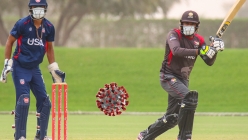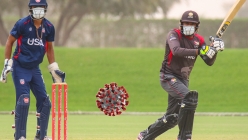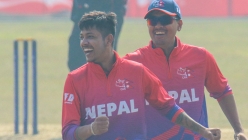USA Cricket: 2013 ICC WCL Division Three Report Card Part 2 - Player Grades
2013 May 13 by DreamCricket USA
Massiah's tactical decisions sometimes left a lot to be desired and in some ways were eerily similar to some of the decisions made when USA flopped in Hong Kong at 2011 ICC WCL Division Three.
Now, you can get all the USA Cricket updates via Facebook. Also follow us on Twitter via @dreamcricket
By Peter Della Penna (on Twitter)
Click here for Part 1 - Team Grades
Part 2 - Player Grades
Steven Taylor – C: The 19-year-old started off the tournament in style by posting USA’s second highest score in limited overs cricket, 162 off 102 balls to lead USA to a win over Nepal. Without Taylor’s dominant performance USA might not have won that match. However, he seemed to have exhausted himself in that match. Low scores piled up in the next few games and his confidence wavered heading into the crucial showdown against Bermuda. After scoring a century against Bermuda in a T20 encounter last March in Florida, Taylor was out for 9 against them in the round-robin encounter in Bermuda.
With the pressure off the next day in the third place game, he set about rebuilding his confidence with 97. His huge score against Nepal helped place him atop the tournament run charts after the round-robin stage and his half-century against Bermuda on the final day guaranteed him the same position at the end of the tournament. Unfortunately, he lacked consistency from game to game. Still, USA should not have had to rely solely on Taylor to score runs to register a win over Uganda or Bermuda.
As for his wicketkeeping/fielding skills, Taylor was as likely to hold onto a chance as to put one down. He took six catches and had three stumpings with the gloves on, but DreamCricket.com’s unofficial stats show he also dropped six chances – five behind the stumps and one in the outfield. In T20s, it appears that Akeem Dodson may get more of the wicketkeeping workload to keep Taylor fresh but in the 50-over game Taylor is the preferred option to keep the batting solid. USA won’t be playing a 50-over ICC tourney for at least two years but if they want to continue using Taylor as a keeper instead of a specialist batsman in that format then he needs to work very hard to improve his glovework, not to mention his fitness, to be able to make it through tournaments better.
Orlando Baker – C: The allrounder opened the batting with Steven Taylor on three occasions, producing mixed results. He provided solid support for Taylor on the opening day with 37 as part of a 125-run first-wicket stand, USA’s highest ever partnership against Nepal. Combined with the 156-run third-wicket stand those two had against Bermuda in the third place playoff, they generated the two highest partnerships by any team in Bermuda. He also combined with Akeem Dodson for an important 82-run third wicket stand in their round-robin game.
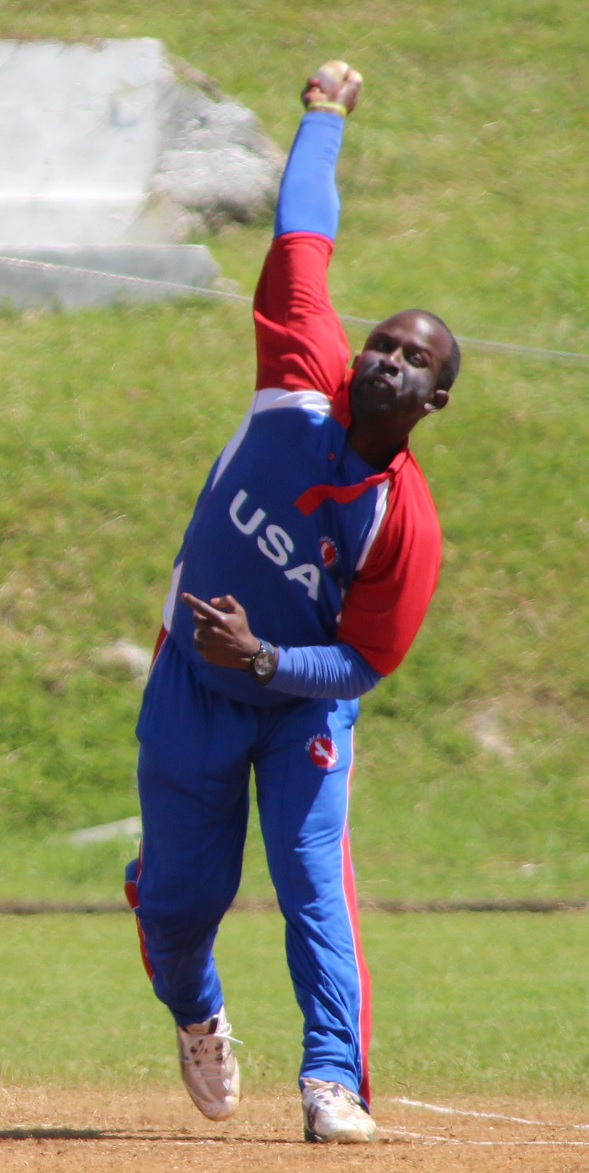 While he was a very good partnership builder, Baker didn’t enjoy the same amount of success individually. He made 2 against Italy, then scored 20 while facing up to the unenviable task of taking on Oman opening pacer Munis Ansari, before wrapping up the group stage with 1 against Uganda and 29 against Bermuda. He finished with 89 runs at 17.80 after the group stage. In the playoff match, he made 72 and in the process became the third USA player to pass 1,000 career runs in 50-over cricket.
While he was a very good partnership builder, Baker didn’t enjoy the same amount of success individually. He made 2 against Italy, then scored 20 while facing up to the unenviable task of taking on Oman opening pacer Munis Ansari, before wrapping up the group stage with 1 against Uganda and 29 against Bermuda. He finished with 89 runs at 17.80 after the group stage. In the playoff match, he made 72 and in the process became the third USA player to pass 1,000 career runs in 50-over cricket.
Image (right) - Orlando Baker bowling at 2013 ICC WCL Division Three. He was USA's most economical seam bowler at the tournament. [Courtesy: Peter Della Penna/DreamCricket.com]
With the ball he was a very restrictive bowler and finished with USA’s second best economy rate, 3.46. He only took one wicket, but had two other chances grassed off his bowling. The conditions against Bermuda on the final day of round-robin play were perfect for Baker’s style of bowling, but USA captain Steve Massiah never gave him the ball, a very curious decision. USA coach Thiru Kumaran stated after the tournament that if he was the captain, he would have definitely given the ball to Baker during Bermuda’s chase. It’s a choice USA may regret for quite a while.
Steve Massiah – D: This is a combination of a C+ for batting and an F for captaincy. Massiah’s highest score was a handy half-century against Italy. After being dropped on 0 off Ansari, Massiah’s 39 against Oman was vital not just for the runs on paper but because he was able to shield the middle and lower order from Ansari’s pace. He top-scored with 24 in USA’s dreadful display against Uganda and then collapsed when the pressure was on in the final round-robin encounter against Bermuda where he was dismissed without scoring. He ended group play with 125 runs at an average of 25.00, then was out first ball in the third place playoff against Bermuda.
His tactical decisions sometimes left a lot to be desired and in some ways were eerily similar to some of the decisions made when USA flopped in Hong Kong at 2011 ICC WCL Division Three. After walking down the pitch in a pressure situation and getting stumped for nought batting at number eight against Oman, Japen Patel was sent in to open in the next game against Uganda. It was as if team management was saying, “We’re afraid this player might fail if he has to enter in a pressure situation later on down the order, so in order to avoid that we’ll send him in to open. Any runs he scores will be a bonus for the team and if he gets out cheaply opening the innings then at least we still have plenty of batsmen to recover.” Disrupting the roles and responsibilities of multiple players to accommodate one player is never a recipe for success. USA proved this by sending Lennox Cush in to open after repeated middle order failures in Hong Kong. USA’s chances for victory against Nepal at Division Four in Malaysia last year were also submarined when Timroy Allen was moved up to number three in the order to shield Massiah, who had been struggling against spin bowling. When USA needed a late surge in that match against Nepal, their best lower order power hitter was back in the pavilion instead of ready to come to the crease.
In the last round-robin match against Bermuda, several strategic errors were made. Slotting Patel in to bat at number nine and not having him bowl was a strange maneuver. Naseer Jamali or Danial Ahmed as specialist bowlers would have been much better options instead of a batsman at number nine. After conceding 20 runs in his only over, Massiah refused to give Hutchinson an opportunity to atone even though he had been USA’s second best wicket-taker coming into the match. Meanwhile, Timroy Allen, who had been struggling with the ball all tournament, was hit for 27 runs off his fourth over but was still brought back for two more spells, albeit bowling spin instead of pace. Allen finished with 1 for 63 off 10 that day.
Massiah also ignored the experienced Orlando Baker, USA’s second most economical bowler in the tournament. Baker is tied for fourth all-time in the wicket-takers list for USA in one-day cricket and has a reputation as a cagey seamer with a nagging line and length that most teams find difficult to score off. Massiah opted to bowl himself instead of Baker. Few, if any other captains, would have tossed the ball to Massiah in those circumstances but he stubbornly bowled himself. With USA needing to keep Bermuda under four an over, he finished with a spell of 1 for 41 in eight overs. Even with only 220 to defend, USA should have beaten Bermuda that day. A combination of poor fielding and poor decision-making before and during the match cost USA not just that game, but a spot in the 2014 ICC World Cup Qualifier.
.jpg) Sushil Nadkarni – B-: USA’s vice-captain stepped up with a key 73 to bolster USA in a win over Italy and was part of three half-century stands in the tournament, one against Nepal and another two against Italy. He was sent in above Massiah to try to deal with Ansari’s pace against Oman and managed just 7 before making another low score after arriving in the middle order in difficult conditions against Uganda.
Sushil Nadkarni – B-: USA’s vice-captain stepped up with a key 73 to bolster USA in a win over Italy and was part of three half-century stands in the tournament, one against Nepal and another two against Italy. He was sent in above Massiah to try to deal with Ansari’s pace against Oman and managed just 7 before making another low score after arriving in the middle order in difficult conditions against Uganda.
Image (left) - Sushil Nadkarni knocks one into the off side against Italy. [Courtesy: Peter Della Penna/DreamCricket.com]
Nadkarni took three catches, including the catch of the tournament for USA against Uganda. USA missed him badly against Bermuda when he had to sit out the final two matches of the tournament with a nerve problem in his left leg, especially since Nadkarni had scored a century against Bermuda in the trial matches in March in Florida ahead of Division Three. He finished the tournament with 114 runs at an average of 28.50, fifth on the team in Bermuda.
Rashard Marshall – B: The middle order batsman produced one of USA’s best ever performances under pressure against Oman. Entering in the 10th over with USA 37 for 3, Marshall survived a missed runout chance early in his innings and went on to make Oman pay, cracking four boundaries and six sixes on his way to finishing 72 not out and taking USA to a two-wicket win. He arrived at a stage against Bermuda where he needed to take USA to a much bigger total but he got into a mixup with Barrington Bartley which ended with Marshall going back to the pavilion for 5.
Marshall finished fourth overall in runs and average at the tournament for USA with 128 at 32.00. He took an outstanding one-handed catch against Bermuda, but also grassed three other chances which is unusual for someone of his fielding ability. It was a decent comeback tournament for Marshall after not playing for USA in over two years.
Timroy Allen - C: Like Taylor, Allen was hot with the bat early in the tournament before cooling off later on. He scored two half-centuries in USA’s first two matches, 67 not out against Nepal followed by 51 not out against Italy. Unfortunately, he only scored 24 runs in the other four matches. He played a foolish shot to get out against Uganda, slogging to deep square leg after Baker had gotten out in the same manner a short time earlier. Against Bermuda he reached 19 before being caught on the boundary which hampered USA’s efforts to post a bigger score. Like Taylor, it would be unfair to pin USA’s batting failures at the back end of the tournament on Allen when several players never produced in any game.
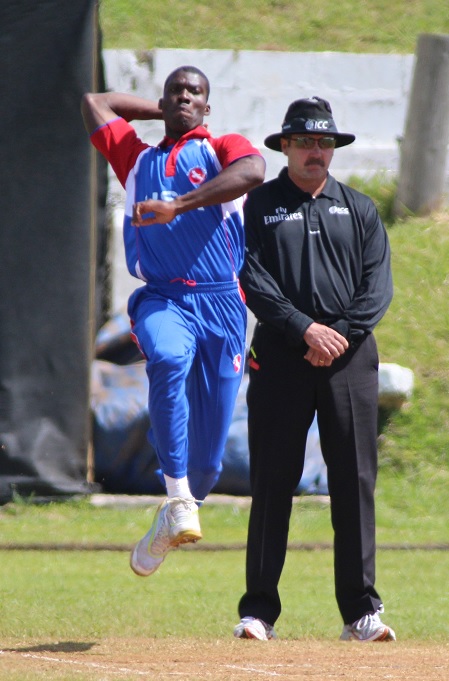 With the ball he was a disappointment, taking four wickets at an average of 51.75 with an economy rate of 5.17 during the group stage. He went for more than five an over against Uganda, taking 2 for 37 in seven overs when Uganda only made 175, and was smacked for 27 off one over against Bermuda before finishing with 1 for 63 in 10. A bigger burden was placed on Allen to perform with the ball in the absence of the experienced Usman Shuja but Allen did not respond very well.
With the ball he was a disappointment, taking four wickets at an average of 51.75 with an economy rate of 5.17 during the group stage. He went for more than five an over against Uganda, taking 2 for 37 in seven overs when Uganda only made 175, and was smacked for 27 off one over against Bermuda before finishing with 1 for 63 in 10. A bigger burden was placed on Allen to perform with the ball in the absence of the experienced Usman Shuja but Allen did not respond very well.
Image (right) - Timroy Allen, pictured in action against Uganda, struggled to take wickets in Bermuda. [Courtesy: Peter Della Penna/DreamCricket.com]
Barrington Bartley – D: Undoubtedly the poorest performing player on tour. There were high expectations for Bartley after his whirlwind century against Bermuda in a trial match against them in March. He assumed a key middle order role for USA in Bermuda but did not deliver once. Bartley came to the crease at the 37th, 45th, 34th, 26th, 31st and 38th over mark during USA’s six games in Division Three. He was never able to remain until the end of the innings. His longest stay at the crease lasted just 20 deliveries when he made 21 but also contributed to the runout of Marshall against Bermuda. His one redeeming moment with the bat came against Oman when he struck two sixes and a four in his short stay to take USA within seven runs of victory before Marshall and Hutchinson finished the job. The largest partnership Bartley contributed to was a 29-run sixth wicket stand in the round-robin match against Bermuda. Overall, he looked like a Twenty20 slogger who seemed unsure how to approach a 50-over innings, especially during difficult situations.
With the ball he was mediocre, taking three wickets during the group stage at an average of 39.66 and an economy rate of 4.40. He was arguably USA’s best bowler in a losing effort against Uganda, taking 1 for 25 in 10 overs. After his failures with the bat, he had one more chance to save face with the ball against Bermuda but he mixed in boundaries with dots and could not sustain pressure long enough to keep them at bay. He was okay as a fielder but did not do enough with bat or ball.
Neil McGarrell – A-: One of the few players who can hold their head up high after coming back from Bermuda, McGarrell performed at a consistently high level in what may turn out to be his only ICC tournament in a USA uniform. He was USA’s leading wicket-taker and finished the group stage tied for the tournament lead in wickets with 12 at an average of 14.58 and an economy rate of 3.55. He only bowled one truly bad over the entire tournament when he was swept for three boundaries by Laurence Sematimba of Uganda.
He could’ve been even more productive with the ball had five catches not been put down off his bowling, although one of those was a return chance he was responsible for. In the field, he took one catch but managed to shell three chances overall, including a crucial chance off Christopher Douglas at slip when the Bermuda wicketkeeper was on 64. It was the only blemish on his gritty performance that day when he scored 45 not out at number seven and then took 1 for 21 in 10 overs while bowling with a severe quadriceps strain that he suffered near the end of his innings while trying to turn a two into three for Patel.
Japen Patel – C-: USA’s selectors and management have clearly identified Patel as a player they want to develop, but they have demonstrated a bizarre method of doing it. The selectors could be heard in Florida in March talking up his bowling skills as a reason for his inclusion but Patel only bowled a total of seven overs in the tournament, taking two wickets against Oman. It was hard to classify him as a specialist batsman either. He didn’t bat at all against Nepal when USA used eight batsmen, came in twice at nine, once at eight, and opened once during USA’s five group games scratching together 46 runs at an average of 11.50. He eventually added another 34 in the third place playoff against Bermuda batting at number six.
Patel was a player without a clearly defined role. If you were from the opposition, you might be fooled into thinking he was playing for USA as a specialist fielder. Indeed he was an asset for USA in the field, taking two catches and also pulling off two runouts but also spilled two other chances. He was very sharp at attacking the ball and preventing singles from turning into twos while patrolling the boundary.
At the end of the day though, picking someone to bowl one over against Nepal and then not at all against Italy and Bermuda after being penciled in at number nine in the batting order would appear to be a mistaken selection. If Patel is to have a future with USA it would be with his batting, which has improved somewhat since he first made his USA debut in 2011 but still has miles to go to warrant a spot in a starting eleven.
Elmore Hutchinson – B-: Hutchinson had his best tour in a USA uniform and was USA’s best pace bowler on tour. He took eight wickets in the group stage and finished with 10 overall, second behind only McGarrell for USA. His best haul came against Italy, taking 3 for 44 in nine overs, but he also turned in solid figures against Uganda with 1 for 12 in five overs. Hutchinson had a nightmarish over at the start of Bermuda’s chase at the National Stadium, conceding four boundaries to Christopher Douglas as part of a 20-run frame, and was never given the ball again that day.
With the bat he finished with USA’s highest average on tour, scoring 52 runs while being dismissed only once, which says as much about his own batting abilities as it does about the impatience of those batting in front of him. He hit the winning single in a two-wicket victory over Oman and also finished 17 not out off 35 balls against Uganda, the third most runs scored and third most deliveries faced by a USA batsman that day, proving that it was possible to knock the ball around for singles for those with the patience to do so. Hutchinson also had a fairly safe pair of hands on the boundary with three catches while his only drop was a sharp caught and bowled chance. It’s a shame that his next 50-over ICC tournament might not be for another two years because he made solid strides in this event.
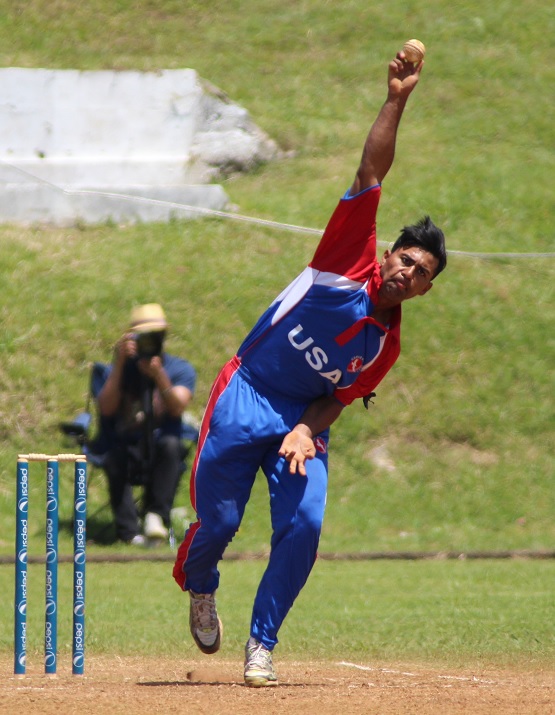 Muhammad Ghous – B+: This was one of the more impressive tournament performances of Ghous’ career in the men’s national team. Unfortunately it had to come in what was ultimately a third place finish. He was USA’s most economical bowler and finished with a 3.42 economy rate overall in the tournament. Along with McGarrell’s 10-over spell, the initial eight-over spell by Ghous of 0 for 21 in eight overs against Bermuda was the only thing keeping USA in that match.
Muhammad Ghous – B+: This was one of the more impressive tournament performances of Ghous’ career in the men’s national team. Unfortunately it had to come in what was ultimately a third place finish. He was USA’s most economical bowler and finished with a 3.42 economy rate overall in the tournament. Along with McGarrell’s 10-over spell, the initial eight-over spell by Ghous of 0 for 21 in eight overs against Bermuda was the only thing keeping USA in that match.
Image (left) - Muhammad Ghous was USA's most economical bowler at 2013 WCL Division Three. [Courtesy: Peter Della Penna/DreamCricket.com]
He only took five wickets in the group stage but also had five drops off his bowling in the tournament and batsmen found him difficult to get away. His only subpar match was against Uganda and even then he went for under five runs per over, finishing with 1 for 37 in eight overs. His four wickets against Bermuda in the third place playoff took him to a tie with Allen and Howard Johnson for ninth all-time in the wickets column for USA in one-day cricket with 31. He turned 23 in April so even though USA failed to reach the 2014 ICC World Cup Qualifier, if they continue to play a 50-over ICC tournament every few years then Ghous may eventually become USA’s highest ever wicket-taker in the format.
Akeem Dodson – Incomplete: The reserve wicketkeeper on tour came into USA’s lineup for the final round-robin encounter against Bermuda and scored a half-century, USA’s high score on the day. He only came in as a result of an injury to Sushil Nadkarni, but USA might have been better served playing him earlier in the tour as a wicketkeeper to allow Taylor to play as a specialist batsman and ease his workload.
Naseer Jamali – Incomplete: Did not play in any of the five round-robin matches and took 1 for 21 in four overs against Bermuda in the third place playoff.
Danial Ahmed – Incomplete: Did not play in any of the five round-robin matches and took 0 for 38 in eight overs against Bermuda in the third place playoff.
Coming up in Part 3 – Outlook for USA’s 50-over future
[Views expressed in this article are those of the author who was present at all of the team's matches. If you have differing views or opinions, we respect those views and urge you to provide your feedback - both positive and negative - in the comments section.]

